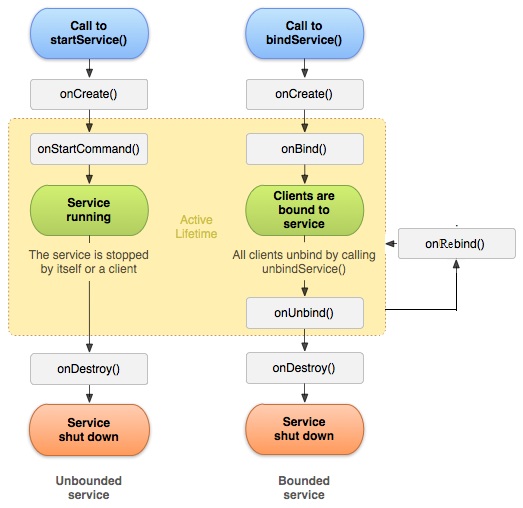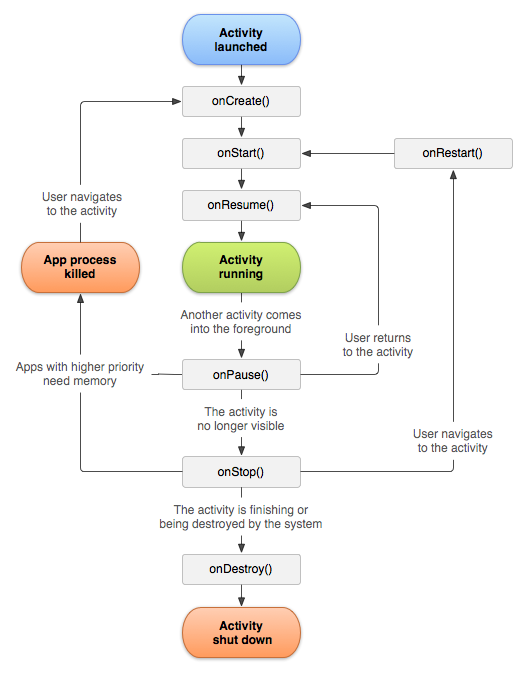A service is an application component that can run some long running task in the background without the need for a user interface. Some other application component can start the service and this service will then keep on running even if the user switches to another application.
A service can essentially take two forms:
Unbounded
A service is "started" when an application component (such as an activity) starts it by calling startService(). Once started, a service can run in the background indefinitely (unbounded), even if the component that started it is destroyed. Usually, a started service performs a single operation and does not return a result to the caller. For example, it might download or upload a file over the network. When the operation is done, the service should stop itself.
Bound
A service is "bound" when an application component binds to it by calling bindService(). A bound service offers a client-server interface that allows components to interact with the service, send requests, get results, and even do so across processes with interprocess communication (IPC). A bound service runs only as long as another application component is bound to it. Multiple components can bind to the service at once, but when all of them unbind, the service is destroyed.
As you can see in diagram there some method in Unbounded service class for life cycle :
startService(Intent Service)
This you must call to start un-bounded serviec
onCreate()
This method is Called when the service is first created
onStartCommand(Intent intent, int flags, int startId)
This method is called when service is started
onBind(Intent intent)
This method you must call if you want to bind with activity
onUnbind(Intent intent)
This method is Called when the service will un-binded from activity
onRebind(Intent intent)
This method is called when you want to Re-bind service after calling un-bind method
onDestroy()
This method is called when The service is no longer used and is being destroyed
Let's create a small app to understand this..
-------------------------------------------
App Name: ServiceLifeCycle
Package Name: com.rdc
Android SDK: Android SDK 2.3.3 / API 10
Default Activity Name: MyActivity
-------------------------------------------
MyActivity.java
MyService
main.xml
AndroidManifest.xml
The output Screen will be like this..
You can download the complete source code zip file here : ServiceLifeCycle
Cheers!!
I'd love to hear your thoughts!
A service can essentially take two forms:
Unbounded
A service is "started" when an application component (such as an activity) starts it by calling startService(). Once started, a service can run in the background indefinitely (unbounded), even if the component that started it is destroyed. Usually, a started service performs a single operation and does not return a result to the caller. For example, it might download or upload a file over the network. When the operation is done, the service should stop itself.
Bound
A service is "bound" when an application component binds to it by calling bindService(). A bound service offers a client-server interface that allows components to interact with the service, send requests, get results, and even do so across processes with interprocess communication (IPC). A bound service runs only as long as another application component is bound to it. Multiple components can bind to the service at once, but when all of them unbind, the service is destroyed.
As you can see in diagram there some method in Unbounded service class for life cycle :
startService(Intent Service)
This you must call to start un-bounded serviec
onCreate()
This method is Called when the service is first created
onStartCommand(Intent intent, int flags, int startId)
This method is called when service is started
onBind(Intent intent)
This method you must call if you want to bind with activity
onUnbind(Intent intent)
This method is Called when the service will un-binded from activity
onRebind(Intent intent)
This method is called when you want to Re-bind service after calling un-bind method
onDestroy()
This method is called when The service is no longer used and is being destroyed
Let's create a small app to understand this..
-------------------------------------------
App Name: ServiceLifeCycle
Package Name: com.rdc
Android SDK: Android SDK 2.3.3 / API 10
Default Activity Name: MyActivity
-------------------------------------------
MyActivity.java
package com.rdc;
import android.app.Activity;
import android.content.Intent;
import android.os.Bundle;
import android.util.Log;
import android.view.View;
import android.view.View.OnClickListener;
import android.widget.Button;
public class MyActivity extends Activity
implements OnClickListener {
private final static String TAG = "In this method: ";
private Button startSerivce = null;
private Button stopSerivce = null;
@Override
public void onCreate(Bundle savedInstanceState) {
super.onCreate(savedInstanceState);
setContentView(R.layout.main);
startSerivce = (Button) findViewById(R.id.buttonStart);
startSerivce.setOnClickListener(this);
stopSerivce = (Button) findViewById(R.id.buttonStop);
stopSerivce.setOnClickListener(this);
}
@Override
public void onClick(View v) {
if (startSerivce == v) {
Log.i(TAG, "Activity starting service..");
Intent serviceIntent = new Intent(this, MyService.class);
startService(serviceIntent);
} else {
Intent in = new Intent(this, MyService.class);
in.setAction("stop");
stopService(in);
}
}
}
MyService
package com.rdc;
import android.app.Service;
import android.content.Intent;
import android.os.IBinder;
import android.util.Log;
import android.widget.Toast;
public class MyService extends Service {
private final static String TAG = "In this method: ";
int mStartMode; // indicates how to behave if the service is killed
IBinder mBinder; // interface for clients that bind
boolean mAllowRebind; // indicates whether onRebind should be used
@Override
public void onCreate() {
Log.i(TAG, "Service created");
// The service is being created
}
@Override
public int onStartCommand(Intent intent, int flags, int startId) {
Log.i(TAG, "Service started");
Toast.makeText(getBaseContext(), "Service has been started..",
Toast.LENGTH_SHORT).show();
return mStartMode;
}
@Override
public IBinder onBind(Intent intent) {
// A client is binding to the service with bindService()
Log.i(TAG, "Service binded");
return mBinder;
}
@Override
public boolean onUnbind(Intent intent) {
// All clients have unbound with unbindService()
Log.i(TAG, "Service un-binded");
return mAllowRebind;
}
@Override
public void onRebind(Intent intent) {
// A client is binding to the service with Re-bindService(),
// after onUnbind() has already been called
Log.i(TAG, "Service re-binded");
}
@Override
public void onDestroy() {
// The service is no longer used and is being destroyed
Log.i(TAG, "Service destroyed");
}
}
main.xml
<?xml version="1.0" encoding="utf-8"?> <LinearLayout xmlns:android="http://schemas.android.com/apk/res/android" android:orientation="vertical" android:layout_width="fill_parent" android:layout_height="fill_parent" android:gravity="center"> <LinearLayout android:layout_height="wrap_content" android:layout_width="match_parent" android:id="@+id/linearLayout1" android:gravity="center"> <Button android:layout_height="wrap_content" android:layout_width="wrap_content" android:id="@+id/buttonStart" android:text="Start Service"></Button> <Button android:layout_height="wrap_content" android:layout_width="wrap_content" android:id="@+id/buttonStop" android:text="Stop Serivce"></Button> </LinearLayout> </LinearLayout>
AndroidManifest.xml
<?xml version="1.0" encoding="utf-8"?> <manifest xmlns:android="http://schemas.android.com/apk/res/android" package="com.rdc" android:versionCode="1" android:versionName="1.0"> <uses-sdk android:minSdkVersion="8" /> <application android:icon="@drawable/icon" android:label="@string/app_name"> <activity android:name=".MyActivity" android:label="@string/app_name"> <intent-filter> <action android:name="android.intent.action.MAIN" /> <category android:name="android.intent.category.LAUNCHER" /> </intent-filter> </activity> <service android:enabled="true" android:name=".MyService"> <intent-filter> <action android:name="com.rdc.MyService"> </action> </intent-filter> </service> </application> </manifest>
The output Screen will be like this..
You can download the complete source code zip file here : ServiceLifeCycle
Cheers!!
I'd love to hear your thoughts!



